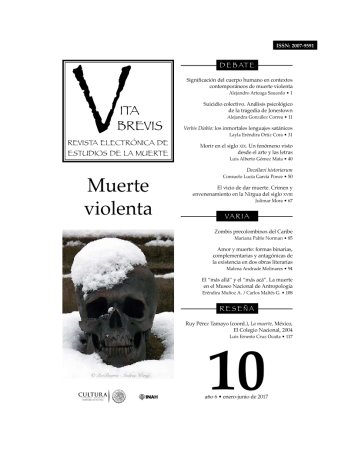Publicado 2017-06-09
Palabras clave
- Decollavi,
- Muerte,
- mártires,
- cefaloforia,
- hagiografía
- novohispano. Keywords,
- Death,
- martyrs,
- cephalophoria,
- hagiography,
- newhispanic ...Más
Cómo citar
Resumen
Resumen:
Las historias de los Decollavi o decapitados es tan antigua como la humanidad misma y en la creación literaria su fuente no se agota, no hay certeza sí fueron reales o sí están muy lejos de la verdadera tradición, pero fueron trasmitidas de generación en generación, expresadas de manera oral o por imágenes. Así estos relatos a la vez se envuelven y fusionan con elementos del legado sociocultural de las sociedades o de los diferentes grupos que las creo.
Estas narraciones cada cultura las usó con diferentes objetivos, pero por lo general han servido de ejemplo, manteniendo valores o normas de conducta, costumbres, usos sociales e ideologías entre otros. El artículo versa sobre como el cristianismo toma prestadas estas tradiciones para establecer el código moral de su religión, por lo tanto, crea hagiografías de Cefaloforias, como fenómeno milagroso de amor incondicional, donde los predicadores de la moral mueren por su religión.
Abstract
The stories of the Decollavi or decapitated are as old as humanity itself and in literary creation its source is not exhausted, there is no certainty if they were real or if they are far from the true tradition, but were transmitted from generation to generation, expressed orally or by image. Thus, these stories are both involved and fused with elements of the socio-cultural legacy of societies or different social groups that create them.
The narratives each culture used them with different objectives, but usually have served as an example, maintaining values or standards of conduct, customs, social uses and ideologies among others. The article deals with how Christianity borrows these traditions, to establish the moral code of its religion, therefore creates hagiographies of Cephaloforia, as a miracle phenomenon of unconditional love, where the preachers of morality die for their religion.
Descargas
Referencias
- Castoriadis, Cornelius. 2001. Figuras de lo pensable. Argentina, F.C.E.
- De La Torré, Renee. 2013. “La Religiosidad Popular. Encrucijada de las nuevas formas de la religiosidad contemporánea y la tradición (el caso de México)” en Pont Urbe, 12. México, p. 18ss
- Lacolla, Liliana. 2005. “Representaciones sociales: una manera de entender las ideas de nuestros alumnos”, en: Revista ieRed: Revista Electrónica de la Red de Investigación Educativa [en línea]. Vol.1, No.3 (Julio-Diciembre de 2005). Disponible en Internet: citando a Denise Jodelet
- Incera, Hernández Nadiosly. “Apuntes acerca de la teoría de las representaciones sociales”, en Monografías, [en línea]. Disponible en Internet: monografias.com
- Villegas, Alonso. Fructus Sanctorum, Discurso 65

